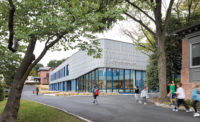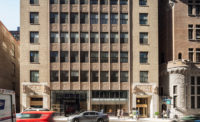Happy Trailers at Riverdale County School by Architecture Research Office
New York

Riverdale’s third through fifth graders voted on a selection of graphics, designed by Open, to define the exteriors of their temporary classrooms.
Photo © Sean Shapiro

Riverdale’s third through fifth graders voted on a selection of graphics, designed by Open, to define the exteriors of their temporary classrooms.
Photo © Sean Shapiro

Riverdale’s third through fifth graders voted on a selection of graphics, designed by Open, to define the exteriors of their temporary classrooms.
Photo © Sean Shapiro

Riverdale’s third through fifth graders voted on a selection of graphics, designed by Open, to define the exteriors of their temporary classrooms.
Photo © Sean Shapiro

Students convene in the Learning Complex’s “Make” and “Look” spaces for creative projects and presentations. These adaptable rooms act as a testing ground for common spaces in ARO’s new Perkins Building, which is scheduled to open for the next school year.
Photo © Sean Shapiro

Students convene in the Learning Complex’s “Make” and “Look” spaces for creative projects and presentations. These adaptable rooms act as a testing ground for common spaces in ARO’s new Perkins Building, which is scheduled to open for the next school year.
Photo © Sean Shapiro

ARO collaborated with Open and Rockwell Group on the site plan of the Learning Complex. Each grade’s classrooms are clustered around their own courtyard, with collaborative “Make” and “Look” spaces defining the middle zone.
Image courtesy Architecture Research Office







Architects & Firms
When ARO began designing a new building for the Riverdale Country School’s third through fifth graders, to be located on the site of the existing elementary school, it faced a familiar challenge: where would they house students and teachers during the year-and-a-half construction project?
Instead of the typical cluster of dreary modular classrooms crammed in a schoolyard or parking lot, ARO devised a playful solution for a corner of the private school’s lush campus overlooking the Hudson River in The Bronx, New York. The architects mapped out 13 trailers: three classrooms for each grade, plus restrooms and two shared creative spaces. While the units themselves are standard trailer-like structures—prefabricated off-site by Williams Scotsman—the architects configured them to form their own mini-campus, collaborating with the Rockwell Group and Open to determine a site plan that would establish insularity while maintaining access to nearby facilities. The school gave the site its own name: the Learning Complex.
Eye-popping super-graphics define each unit, infusing the site with youthful energy. Open, a design studio, offered each grade a selection of colors and cheerful insignia and asked them to vote for their favorites; the winners were painted onto the trailers. The units’ interiors vary by grade as well; ARO worked with the Rockwell Group to determine the fit-out of each classroom, choosing and arranging furnishings to suit various co-teaching models.
According to ARO principal Kim Yao, the temporary site also functions as a testing ground for the new building, which is scheduled to be completed in time for the 2016–17 school year. “The Learning Complex has to enact the things we want the building to enact,” she says. Central to this experimental outlook are the complex’s “Make” and “Look” units, which face each other at the site’s core. The former is filled with resources for art projects and science experiments; the latter offers room for students to pin their work on the walls or gather for presentations. These collaborative spaces will be scaled up in the new building.
Planted on the stretch between the Make and Look spaces is a signpost that cheerfully points students to an array of locales, nearby and global, that includes each grade’s classrooms, the Hudson—and Mount Everest. To the north, though not noted on the signpost, construction workers have just topped off the steel structure of the new building.
Administrators had worried about how students and faculty would adjust to the temporary quarters. But, according to Tim Sacks, co-director of Lower School Admission, people have embraced the situation.
“It’s been a reflective year for the school,” he says. “We’re learning to be more fluid in the way we work.”












